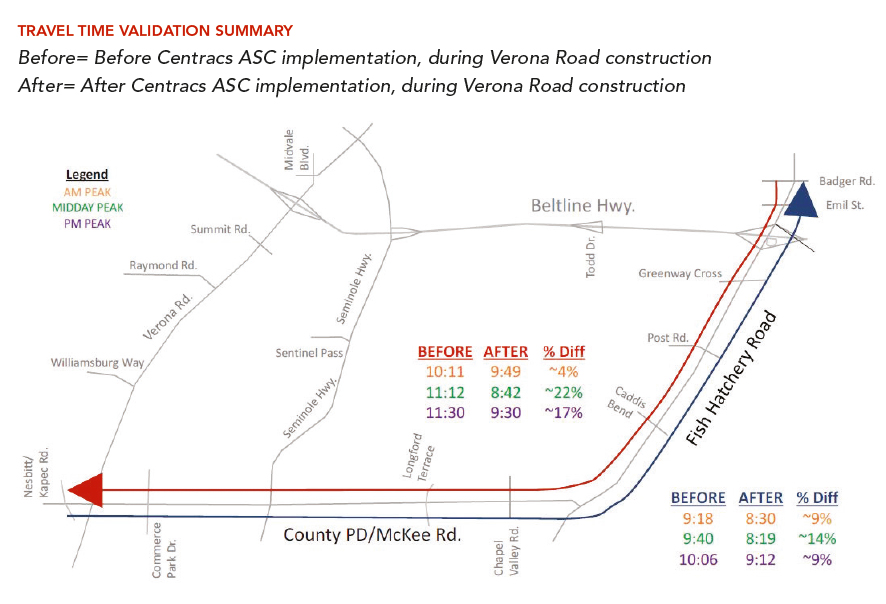
Planned roadway improvements prompted the use of Adaptive Signal Control around Madison – a move that has proved successful as Scott Langer explains.
Madison, Wisconsin’s state capital and second largest city (after Milwaukee), is the county seat of Dane County and home of the University of Wisconsin. With affordable housing, nationally ranked schools, one of the best healthcare systems, low unemployment and thriving cultural and community events, last year Madison topped Money magazine’s ‘Best Places to Live’ table. Furthermore, according to Forbes magazine, Madison is among the “Best Places for Business and Careers” and headed its list of ‘Ten Cities for Job Growth’ during the recession with an unemployment rate of only 3.5%.
Between 1970 and 2000 Dane County’s population grew by 1.6% annually while Madison averaged about 1%; currently its population stands at around 250,000 and the US Census Bureau predicts similar growth through to 2030. The consequential rise in traffic volume is already creating capacity pressures on the roadways in and around Madison, and planners do not see relief anytime soon.
For these reasons, transportation management has become an increasingly important focus for the City of Madison and the Wisconsin Department of Transportation (WisDOT). WisDOT and the City of Madison identified the Verona Road (US 18/151) corridor – a major commuter route for the area – as experiencing unacceptable levels of crashes, considerably higher than Wisconsin’s other highways. Between 2006 and 2008, there were 342 crashes on one section of the Verona Road which is two to three times the state average for comparable roads. It was observed that traffic had exceeded the roadway capacity and the majority of collisions occurred at intersections. The growth of traffic volumes caused increasing congestion along Verona Road with substantial delays and backups throughout weekdays and evenings and even at weekends during University of Wisconsin events. WisDOT and the neighbouring cities decided to reconstruct the highway to improve the efficiency and increase the capacity of Verona Road.
Named the Verona Road (US 18/151) Project, the two-phased reconstruction is scheduled to be completed in 2019 and will reconfigure the highway to be more like a freeway: eliminating left turns and providing right lane(s) exits. The project will also provide better access for biking and walking throughout the city and area. However, during the construction the traffic needed to be bypassed onto the McKee Rd/Fish Hatchery Rd (north to the Beltline Highway) corridor as an alternate route. City planners and engineers projected this would increase volume on the already high-volume, 6.4km (4mile) corridor by 20%.
Adaptive Signal Control
To address the expected increase in traffic volume on the McKee Rd/Fish Hatchery Rd corridor, the City and WisDOT installed adaptive signal control. Initially the City re-timed the existing signals along the corridor’s 13 intersections to increase the efficiency as much as possible prior to selecting and deploying the adaptive signal control system. Helping the authorities with the complex reconstruction project are regional engineering/construction firm Strand Associates and traffic management consultant Traffic Control Corporation (TCC).
Adaptive signal control system features:
• Centracs Adaptive (module of Centracs ATMS)
• 13 signalised intersections along 6.4km (4mile) stretch of the McKee Rd/Fish Hatchery Rd corridor
•Combination of in- and above-ground vehicle detection
• Proactive deployment ahead of improvement project on bypass corridor
• Actively managing 20% increase in bypass traffic volume onto already high-volume corrido
For the adaptive signal control integration, an Econolite Centracs ATMS system was deployed with an initial license for 250 intersections. The Centracs Adaptive module was activated to initially control the 13 intersections along the McKee Rd/Fish Hatchery Rd corridor. The system utilised a combination of existing and new vehicle detection sensors, including inductive loops, video and radar detection sensors to capture the necessary real-time traffic data for the Centracs Adaptive module. The radar and
In a few instances, the Autoscope Encore video systems were also used for intersection departure detection to provide traffic volume data ahead of the next intersection. This combination of sensor types effectively meets the vehicle detection input data requirements for the adaptive signal control system while enhancing detection performance at various intersections and during varying weather and daylight conditions.
Results
Once the system was activated, the city’s traffic engineers immediately started to notice reduced travel times and fewer stops in comparison with the re-optimised existing signals. This substantiated claims about the effectiveness of adaptive signal control for varying and unique applications but what was surprising was the level of improvement. Before-and-after travel time analysis indicated up to a 22% reduction in travel times and a 65% reduction in stops. This level of improvement is often associated with applications where adaptive signal control is deployed to corridors that have outdated signal timing, or that have never been timed. A key factor in Centracs Adaptive’s improvement over the recent timing plan is that signal timing plans are based on models and a snapshot of the traffic pattern of the corridor at a given time. Since the timing plan is set and covers many hours of the day, it cannot adjust for changes in traffic volume and patterns. The adaptive signal control system enables the corridor to be continuously retimed based on real-time traffic conditions. Strand Associates conducted the before-and-after travel time validation study.
Incident Response
Centracs’ incident response performance also exceeded the city engineers’ expectations. While some adaptive signal control systems have been shown to adjust to traffic incidents or sudden spikes in traffic volumes, these have often been simulations rather than specific real-world cases. Three months after deployment, Beltline Highway closed from 8am to 9:15am as part of the reconstruction project. As a result, there was a significant traffic volume spike (see graph).
Closure of the main highway during the morning peak caused an approximate 40% increase to traffic volume onto the McKee/Fish Hatchery Rd corridor. The sudden spike of traffic volume at around 8am would have likely created gridlock-type conditions on the corridor that might have taken hours to clear. At 8am, Centracs Adaptive immediately recognised the sudden increase in traffic volume and adapted the signal timing to suit the new flow dynamics, bringing travel time back to nominal conditions for the corridor within 30 minutes as can be seen from the illustration.
The adaptive signal control system has proven to be highly effective at helping reduce travel times and unnecessary stops for traffic diverted along the corridor during the reconstruction/highway improvement project. Its performance has helped the authority manage the traffic situation better than expected. In addition, it has proved to be a great tool for incident response.
These high levels of performance have helped validate and legitimise the value of adaptive signal control for many types of applications. City of Madison traffic engineers expect the adaptive system to provide ongoing traffic management benefits after the Verona Road (US18/151) reconstruction project has been completed, and are considering expansion of adaptive signal control to other routes and corridors feeding main highways in the area.
Strand Associates' study confirmed a significant reduction in stops along the corridor at nearly every peak hour.
| PERCENT REDUCTION - Eastbound to Northbound | |||
|---|---|---|---|
| AM Peak Hour (7:00-9:00AM) | |||
| Segment Travel Times | Country PD | Fish Hatchery Road | Average # of stops |
| | 12.7% | 3.7% | |
| Total Travel Time | 8.6% | | 0.0% |
| Midday Peak Hour (11:00AM - 1:00PM) | |||
| Segment Travel Times | Country PD | Fish Hatchery Road | Average # of stops |
| | 7.2% | 21.8% | |
| Total Travel Time | 14.0% | 20.0% | |
| PM Peak Hour 4:00 - 6:00PM) | |||
| Segment Travel Times | Country PD | Fish Hatchery Road | Average # of stops |
| 12.0% | 4.6% | | |
| Total Travel Times | 8.9% | 9.5% |
Eastbound= County PD from Nesbitt/Kapec Road to Fish Hatchery Road
Northbound= Fish Hatchery Road from County PD to Badger Road
| PERCENT REDUCTION - Southbound to Westbound | |||
|---|---|---|---|
| AM Peak Hour (7:00-9:00AM) | |||
| Segment Travel Times | Country PD | Fish Hatchery Road | Average # of stops |
| 13.0% | -5.4% | ||
| Total Travel Time | 3.6% | 4.8% | |
| Midday Peak Hour (11:00AM - 1:00PM) | |||
| Segment Travel Times | Country PD | Fish Hatchery Road | Average # of stops |
| 21.0% | 23.2% | ||
| Total Travel Time | 22.3% | | 65.5% |
| PM Peak Hour 4:00 - 6:00PM) | | ||
| Segment Travel Times | Country PD | Fish Hatchery Road | Average # of stops |
| 14.9% | 19.6% | | |
| Total Travel Time | 17.5% | 36.0% |
Southbound = Fish Hatchery Road from Badger Road to County PD
Westbound = County PD from Fish Hatchery Road to Nesbitt/Kapec Road
About the author: Scott Langer is assistant city traffic engineer for the City of Madison, Wisconsin.











